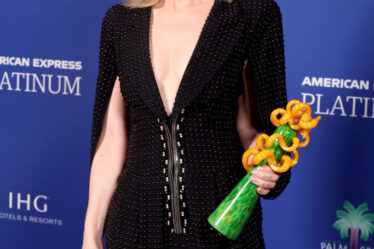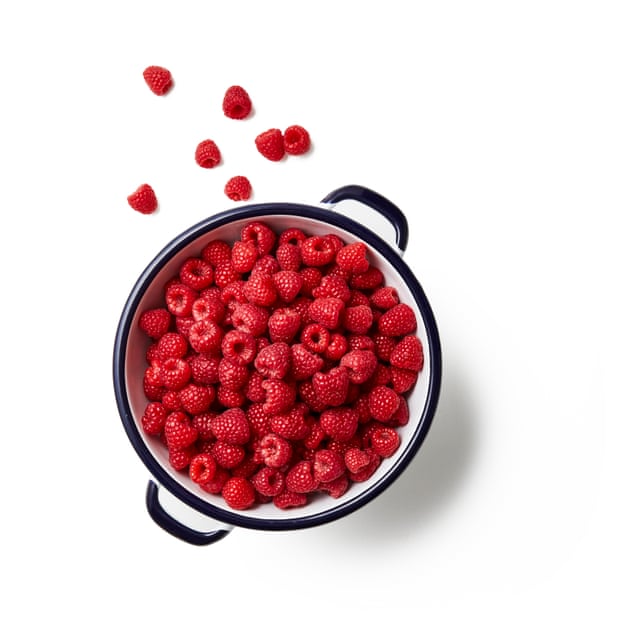
Wibble wobble, wibble wobble, party on a plate – there’s nothing like jelly for making people smile, and not much to touch it for making the most of gluts of summer fruit, particularly when it’s already halfway to warm, sticky jam. Beautiful to behold and light as a feather to eat; a jewel-like jelly is surely the perfect end to a summer celebration, especially as it demands to be prepared well in advance, leaving nothing for you to do but turn it out in triumph and soak up the applause. Yet few of us realise how easy it is to eschew the cubes. Have a go; I promise you nothing you make this year will give you more joy.
The fruit
Having tried one recipe, from Rory O’Connell’s book Master It, where the fruit is suspended in a contrasting jelly (mint flavoured in his case, though Sally Clarke has a version in 30 Ingredients where they’re set in a mixture of their own and apple juice), I decide that I’d prefer the jelly itself to be raspberry flavoured. But I’ll also be adding some whole fruit before it sets to provide some sexy textural contrast, and there are several different approaches to achieving this. In his book Bryn’s Kitchen, chef Bryn Williams mixes the raspberries with sugar and water, puts them over a pan of hot water, and leaves it to sit for an hour until they have given up much of their juice, yielding a beautifully clear, emphatically flavoured result. But, eating the leftover fruit afterwards, it’s clear to me that it had more to give. Jane Grigson’s Fruit Book employs a similar, but slightly more violent tactic in that she heats the water throughout, noting that, by the end of the process, the fruit ought to be reduced to an unappetising “greyish-red debris” which sounds more satisfactory to home cooks hoping to get the most from their ingredients.
Others are even more brutal with the fruit – both Elisabeth Ayrton, who bases her recipe in English Provincial Cooking on a Cheshire manuscript from 1600, and Tom Kerridge, in his very own Best Ever Dishes, puree the fruit, seeds and all, then strain it. Ayrton then boils it up with sugar, and Kerridge sets it with gelatine. Valentine Warner boils the whole fruit and sugar together then strains the mixture afterwards in his book The Good Table, while Rosie Birkett crushes the fruit but doesn’t strain it before use.
Much as I enjoy the texture of raspberry seeds (genuinely!) in the last, I’m drawn to the gorgeous clarity of Williams’ jelly – even the strained examples where the fruit has been pureed first are fairly cloudy – thanks, I think, to those seeds being crushed. The key to success, for me at least, is getting the most from the fruit while also keeping the jelly itself relatively translucent, so I decide to adopt a more interventionist take on Williams’ method, mashing some of the raspberries, and then heating them continuously, as Grigson suggests, to extract more juice from them. (If you don’t mind an opaque result, by all means squeeze as much through the muslin as you can at the end of step 4; I prefer to keep things clear, and eat the contents of the sieve afterwards instead.)
The extras
Ayrton is the only one to call for just raspberries and sugar – everyone else adds additional flavourings of some sort. Though my recipe is all about the raspberries, I’m particularly fond of Kerridge’s use of rose water (which pops up in a Tudor recipe in historian Peter Brears’ scholarly Jellies and Their Moulds) and O’Connell’s sprig of spearmint, which could be added to the bowl of raspberries in step 1.
A jelly made from raspberry juice alone however is, as Ayrton’s recipe proves, incredibly intense – far too much in anything other than very delicate quantities, which means that the juice needs diluting with something. Birkett uses a mixture of fruity white wine and pomegranate juice, which gives her version a lovely purplish colour, and Kerridge opts for pure sparkling wine, which gives his a very adult flavour. Both are, needless to say, delicious, but for me, the other flavours take something away from the raspberries themselves. In fact, unless your fruit is very jammy and sweet, I don’t even think you need the lemon juice many recipes add – though I suspect you can’t go wrong with O’Connell’s dash of raspberry liqueur if you want your jelly to have a bit of a kick.
For extra wow factor, or if you have a slightly larger mould than this calls for, you can set a layer of white chocolate mousse over the top of the raspberry jelly once it’s firm enough to take it, as Birkett does in her book A Lot on Her Plate. It looks extremely impressive, and tastes even better. (Serve the jelly with white chocolate ice cream for a similar effect with rather less effort.)
The setting agent and mould
With one exception, I only try recipes using gelatine, mostly because I can’t find any alternatives, so I’d be interested to know from vegetarians whether agar agar, which can struggle in acidic environments, is effective with fruit jellies. (Ayrton’s relies on the fruit’s natural pectin rather than introducing a setting agent, but I think the 17th century may have had a different interpretation of the word “jelly” than we do, because the results are more like a fruit cheese. Nice with yoghurt though.)
That said, jelly has clearly gone out of fashion in the 21st century; it’s impossible to find a 600ml mould that isn’t shaped like an animal, something that may or may not be desirable at your party. I used a rabbit – but if you don’t happen to have one of those either, you could divide this between four glasses, as Williams recommends, and serve it as individual jellies, or set it in a well-greased cake tin or glass basin. (And, if you’re in the market, I’m reliably informed that charity shops are a good source of second-hand jelly moulds – something to bear in mind once you try this and realise just how good proper jelly can be.)
Perfect raspberry jelly
Makes 600ml (serves 4)
Prep 10 min plus cooling and draining
Cook 1 hr
Set 3 hr+
100g icing sugar
1.1kg raspberries (1kg can be frozen but defrost before use)
Oil, to grease the mould (optional)
5 gelatine leaves
Mix the sugar with 300ml cold water in a large heatproof bowl, then add 1kg raspberries and stir until well mixed – don’t worry if some get crushed.
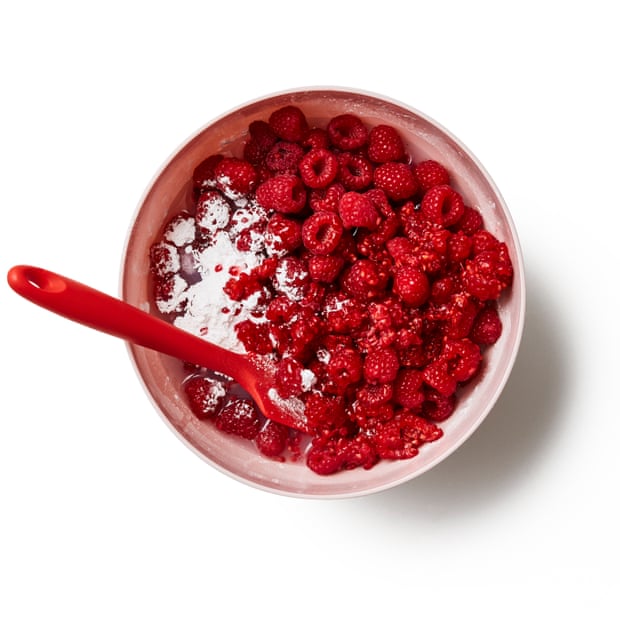
Put the bowl over a pan of simmering water, making sure the bowl doesn’t touch the water, cover and turn down the heat as low as it will go.
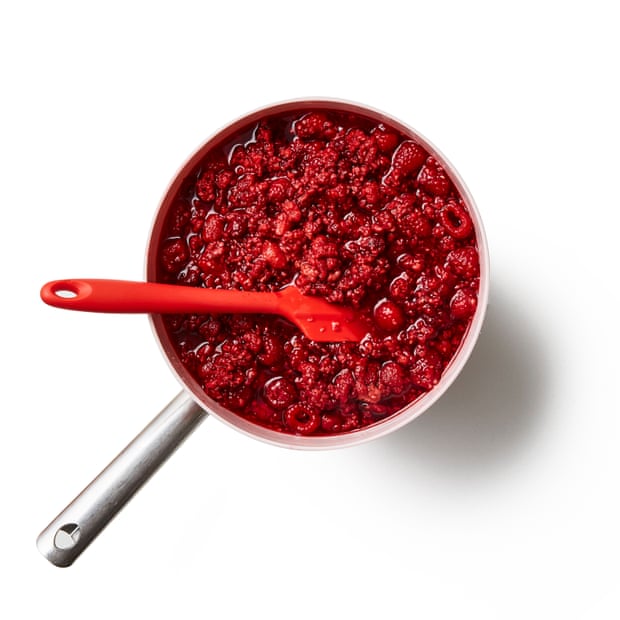
Leave for an hour, making sure it doesn’t boil dry.
Remove the bowl from the pan and leave it to cool for at least an hour.
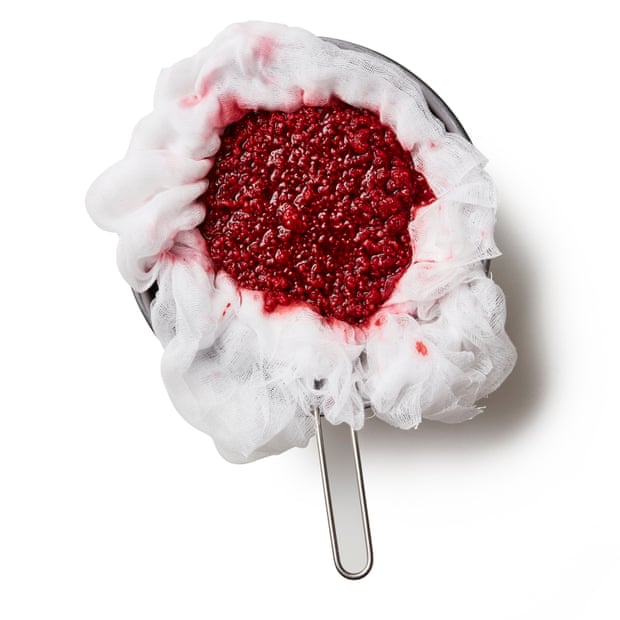
Line a sieve with clean muslin or some other thin material and put it over a tall bowl, then tip in the fruit and juices. Leave to drain for about an hour, stirring once or twice without pressing the fruit through.
You should be left with about 500ml juice. Taste and stir in a little more sugar, or indeed lemon juice, if necessary. Oil generously a 600ml mould (if you’re not planning to turn it out, then there’s no need to do this).

Put the gelatine leaves into cold water to soften. Once pliable, heat about 200ml of the raspberry juice in a small pan and stir in the gelatine until completely dissolved.

Stir back into the rest of the juice, then pour into the mould.
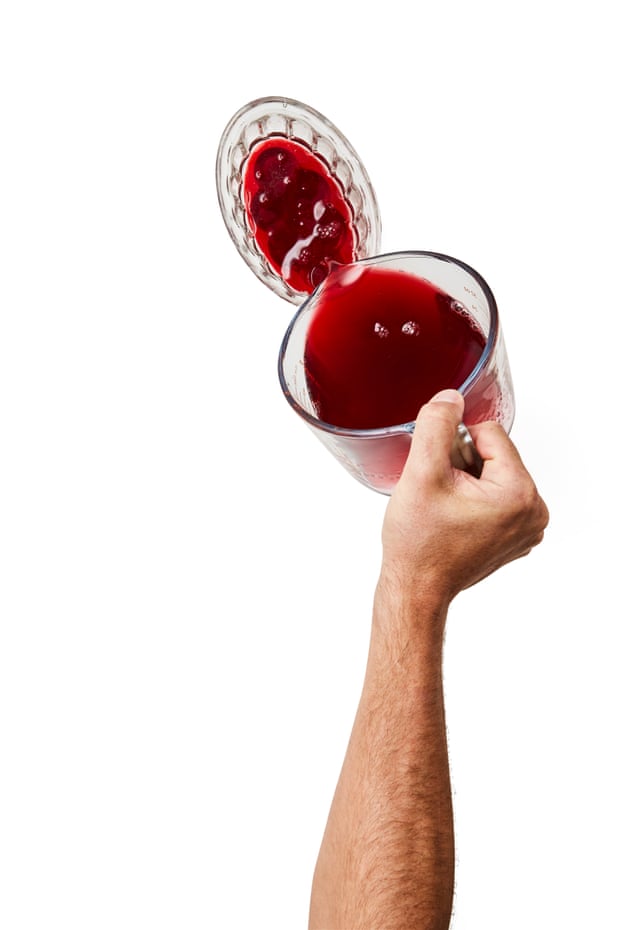
Add the remaining fruit, then leave to set in the fridge – this will take a few hours. To turn out, briefly dip the mould in hot, but not boiling water, then place your serving dish over the top. Invert, and give it a sharp tap to help it on its way.
Jellies – just for kids, or an ancient tradition worth reviving? What are your favourite flavours, and where on earth do you find the moulds?

